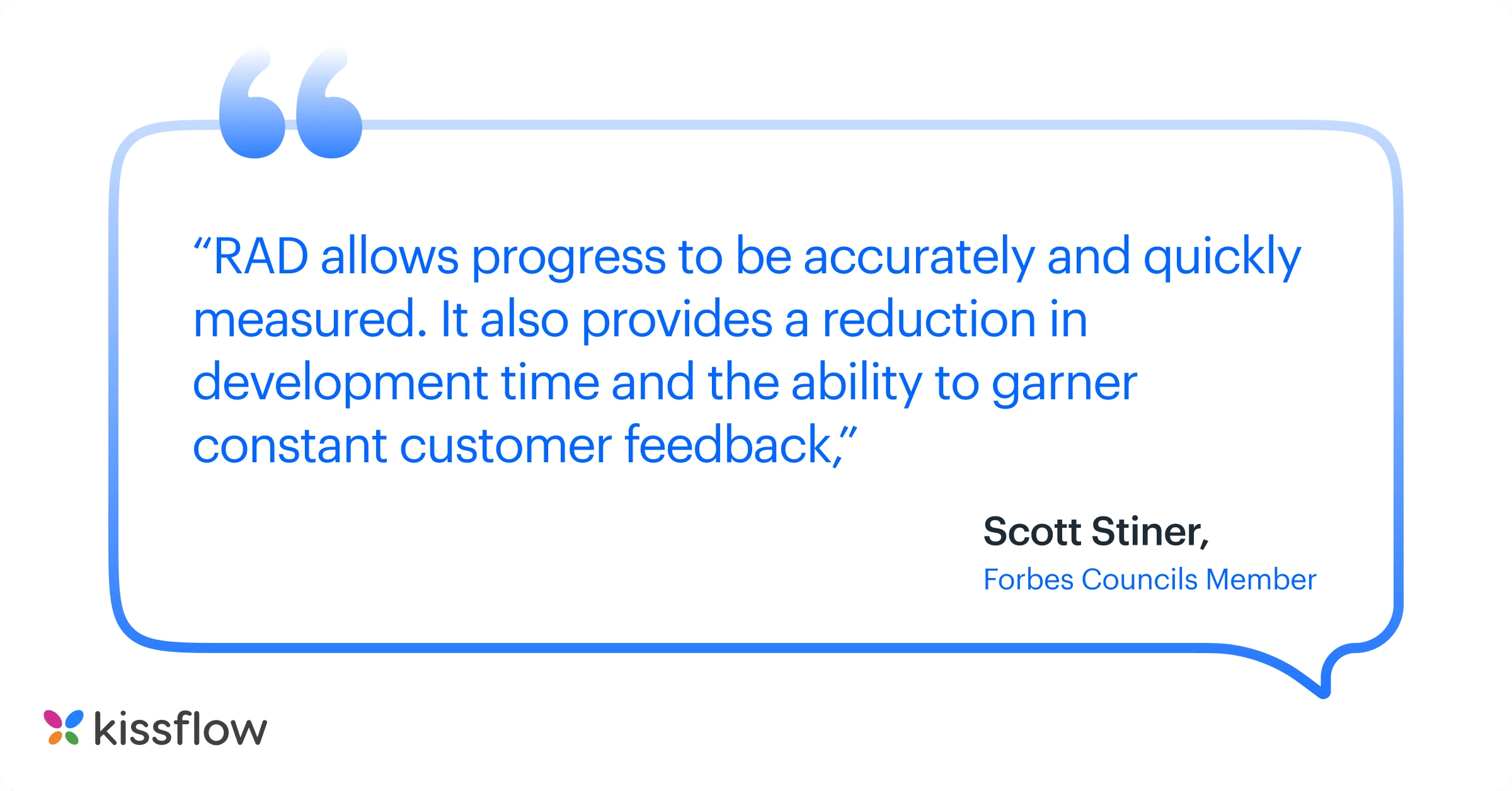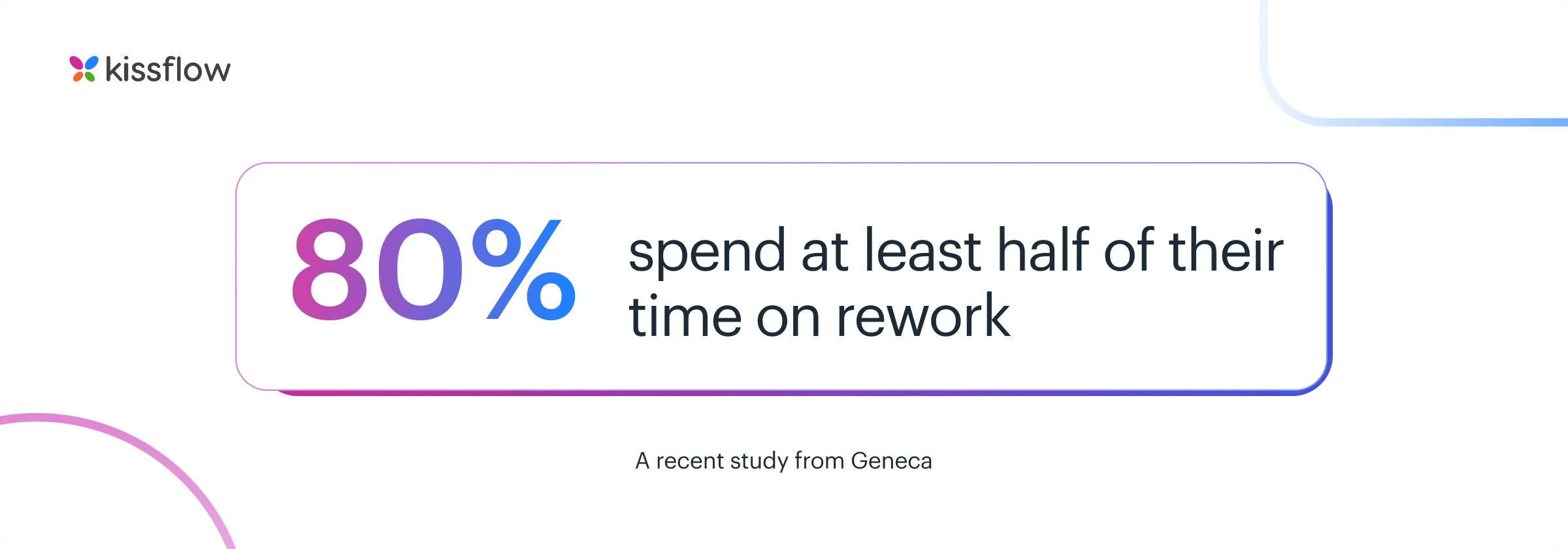
- >
- Application Development >
- RAD and JAD: The Key Differences And Benefits
RAD and JAD: The Key Differences And Benefits
Scaling enterprise application development poses a critical but formidable challenge for CIOs. The right approach to application development can improve enterprise scalability and agility while decreasing time to market.
The two different development approaches that can be considered by organizations are RAD (Rapid Application Development) and JAD (Joint Application Development).
But how do they differ from each other, and which methodology do you use for your business? Let's find out.
RAD vs JAD
Rapid application development (RAD) is an application development process that allows developers to make multiple iterations and updates to software quickly. It’s an agile and progressive development model that emphasizes rapid prototyping and quicker feedback. This ensures that the end product is more quality-focused and aligns with the end-users requirements. RAD helps organizations develop new products and features quickly and stay competitive in a fast-evolving digital world.
Joint application development (JAD) is another common technique used in application development. It brings together key project stakeholders, technology experts, and business representatives through a series of workshops. Its ultimate purpose is to include the client in the development process to develop a better end-product that will meet their needs more efficiently. The client has full autonomy and participates in application development through a series of workshops.
The main differences between RAD and JAD
|
Rapid Application Development |
Joint Application Development |
|
Fewer people are involved in software development. |
Stakeholders work together on software development. |
|
More emphasis is placed on application development and prototyping. |
More emphasis is placed on planning tasks for application development. |
|
The focus is on rapid development and quick deployment of quality technology. |
Feedback is vital during the development phase and gives stakeholders a sense of ownership. |
|
Offers fast-paced app development with the advantage of reduced costs. |
Because of the way systems are designed, the process is expensive. |
|
Requirements can be changed at any time because the method’s key objective is rapid development. |
The end product can’t be changed easily because approval is required from different stakeholders. |
|
Suitable for unstructured projects. RAD developers can make numerous iterations and updates to the product under development without restarting the development schedule. |
Suitable for dynamic system development. It is an effective tool in searching for and correcting issues during system analysis and enhancing design quality. |

How to Choose an App Development Platform for Your Enterprise [ Checklist Included ]
Thank you for reaching us!
Thank you for reaching us!
Benefits of implementing a RAD model
According to Gartner’s survey on mobile apps, the major hurdles to app development are time, cost, and technical skill gaps. RAD lessens the impact of those factors on app development.
The development model focuses on quick prototyping and iterative development and is very different from the JAD model which focuses on planning and sequential design. Here are six benefits of RAD model:
-
Reduced app development cycle time
-
Faster code generation
-
It’s easy to modify apps
-
Rapid user feedback
-
Timely systems integration
-
Aligned IT and business teams
1. Reduced app development cycle time

Because the entire project is divided into modules which are treated as individual prototypes, prototypes can be tested instantly before being combined. This makes for faster app delivery. Businesses find it easier to maintain budgets and schedules and to measure progress. They improve their time to market and achieve their business goals.
“RAD allows progress to be accurately and quickly measured. It also provides a reduction in development time and the ability to garner constant customer feedback,” says Scott Stiner, Forbes Councils Member.
2. Faster code generation
Rapid application development platforms have code generators and allow for code reuse, so there’s less manual coding. Prototypes can be transferred as scripts, so producing working prototypes becomes easier. Processes that would take months or even weeks take days. The model allows developers to work faster while decreasing infrastructure and server needs for cloud development environments.
3. It’s easy to modify apps
Rapid application development makes it compulsory for developers to build independent elements that comprise the final application. Every component is compartmentalized and can be modified to improve the software. This ensures better quality, lower application development costs, and faster development lifecycles.
4. Rapid user feedback
App development usually involves many stakeholders. There are internal teams and stakeholders who approve the project and continually track its progress. These people aren’t IT-savvy and often work in different departments with unique needs. But the feedback they give is essential for successful development.
Because the RAD model allows for continuous feedback, software developers can get feedback from the end users and easily incorporate it to enhance the final product. Development teams get the feedback they require to fast-track the project, while users get the access they need to monitor progress.
5. Timely systems integration
Rapidly developed applications are integrated with other business systems almost immediately. By enabling early integrations, the RAD development model quickly highlights errors within integrations and triggers immediate resolution. Stakeholders can quickly identify and discuss errors, complications, or code vulnerabilities and resolve them without impacting development progress. This reduces risk, which in turn reduces costs.
6. Aligned IT and business teams

80% of IT professionals across the globe admit they spend at least half their time on rework. This happens because of differing views between IT and business users. RAD streamlines the development process by aligning IT and business teams in all processes: requirements planning, design, testing, and implementation. The technology has a shorter planning phase and focuses on highly iterative design and construction, so development teams are able to accomplish more in less time without sacrificing product quality.
RAD is the app development model of choice
RAD’s adaptability allows developers to make multiple iterations and updates to software quickly. There’s no need to restart a development schedule from scratch every time. The model reduces the overall development time due to reusable components and parallel development, enabling rapid delivery.
Development teams can leverage simple code-change capabilities and dramatically enhance the functionalities of finished software without wasting time or overlooking critical errors. Rapid application development also encourages code reuse. Less manual coding means shorter testing times and less room for errors.
Discover how Kissflow Low-Code App Development platform can streamline your development process.
Kissflow's application development platform can simplify and accelerate application development by involving even non-technical users in the development process. With Kissflow’s visual drag-and-drop editor, your apps get developed faster, and the solutions align much more closely with your business requirements. While allowing your business users to leverage their domain experience, Kissflow also lets your IT team take over anytime and manage governance.
Learn more: Best Enterprise Application Development Tools of 2025.
Frequently Asked Questions
1. What is the difference between RAD and JAD?
RAD (Rapid Application Development) is a development methodology focusing on rapid prototyping and iterative development with minimal planning, while JAD (Joint Application Development) is a requirements-gathering technique involving structured workshops with stakeholders. RAD is a complete development approach, whereas JAD is a specific collaborative technique often used within various methodologies, including RAD itself.
2. How does JAD improve business process modeling?
JAD improves business process modeling through structured workshops bringing together key stakeholders, subject matter experts, and technical teams. This collaborative approach ensures comprehensive requirement gathering, reduces misunderstandings, accelerates consensus building, captures diverse perspectives, identifies potential issues early, and creates stakeholder buy-in that improves implementation success rates.
3. What industries prefer RAD over JAD?
Industries preferring RAD over JAD include software startups needing quick market validation, e-commerce companies requiring rapid feature deployment, digital marketing agencies developing client deliverables, mobile app developers in competitive markets, and companies with in-house development teams that can work closely with business users. JAD remains popular in enterprises with complex stakeholder environments.
4. What are real-world examples of RAD vs JAD implementations?
In a healthcare system modernization, RAD was used to quickly develop patient portal prototypes for immediate user testing, while JAD facilitated comprehensive requirements gathering for the more complex electronic health record system. A financial services firm used RAD for customer-facing mobile applications but relied on JAD workshops for compliance-critical back-office systems requiring extensive stakeholder alignment.
5. How do businesses decide between RAD and JAD?
Businesses decide between RAD and JAD based on project characteristics—RAD for projects needing quick delivery with evolving requirements, JAD for complex projects with multiple stakeholders requiring thorough requirements gathering. Many organizations use both: JAD workshops to gather initial requirements, followed by RAD methodology for development when appropriate. Timeline constraints and user availability also influence the decision.
6. How do RAD and JAD differ in focus for application development?
RAD (Rapid Application Development) focuses on quickly building and iterating working software through short cycles and prototypes. JAD (Joint Application Design) focuses on structured workshops to gather and validate requirements collaboratively. RAD is build-centric, while JAD is discussion- and design-session–centric.
7. When should teams prefer RAD over JAD?
RAD is ideal when speed to delivery is critical, requirements are evolving, and stakeholders are available for frequent feedback on working prototypes. It works best when you can quickly test ideas with users rather than relying only on workshop outputs.
8. When is JAD more appropriate than RAD?
JAD is useful when you need deep consensus across stakeholders, complex rules must be documented carefully, or the organization prefers structured, workshop-driven requirement gathering before significant development starts.
9. Can RAD and JAD be combined in the same project?
Yes. Many teams use JAD-style workshops to align on high-level requirements, then switch to RAD cycles to quickly prototype and refine actual solutions using low-code platforms.
10. How does low-code influence RAD vs JAD decisions?
Low-code amplifies RAD’s benefits by making prototyping and iteration very fast. JAD can still be valuable, but with low-code, teams often prefer to validate ideas using real screens rather than only documents.
The fastest way to create high-value apps
-3.webp)
How much could your organization save with low-code?
Get the impact of a low-code/no-code platform on your application development costs
Related Articles
![What is Rapid Framework? | How it Speed Up App Development? [New]](https://kissflow.com/hs-fs/hubfs/rapid-application-development-RAD-thumb.jpg?width=352&name=rapid-application-development-RAD-thumb.jpg)











